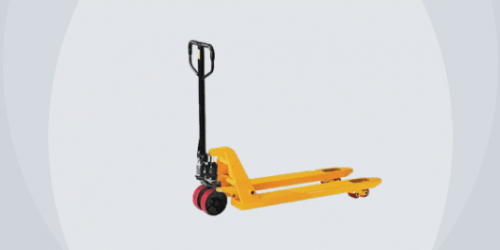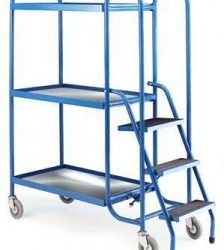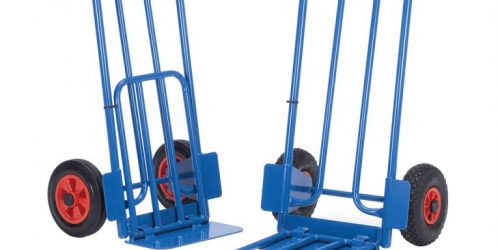Purchasing guide: Choosing the right pallet truck for your warehouse
In the world of logistics and material handling, the pallet truck is an essential tool. Whether it’s for moving pallets around a workshop or efficiently organising stock in your warehouse, choosing the right pallet truck is crucial to ensure productivity and safety in material handling operations. However, with the multitude of options available on the market, selecting the optimal pallet truck can be a real challenge. In this article, discover the different criteria to consider when choosing a quality professional pallet truck. With our advice, make informed decisions before buying and maximise the efficiency of your materials handling equipment.
How to choose your pallet truck?
Discover the essential criteria to consider when choosing your pallet truck.
Load capacity
The load capacity of a pallet truck is crucial to guarantee the efficiency and safety of your materials handling operations. Your choice should be adapted to the weight of the pallets you plan to transport. Depending on your needs, you’ll find a wide range of suitable products on the Manutan site, including hand pallet trucks that can support loads ranging from 750 kg to 3,000 kg. For lighter loads, we recommend turning to other types of equipment, such as a sack truck.
If you need to weigh loads while moving them, particularly to optimise your stock management, then opt for a weigh scale pallet truck.
Fork length
Like load capacity, the fork length of a pallet truck should be chosen based on the type of pallets and specific working spaces. An appropriate fork length allows you to manoeuvre efficiently and safely.
There are different fork lengths available:
- Short forks (800 mm) are particularly popular in the retail sector. They offer great manoeuvrability, making it easier to move between narrow store aisles.
- Standard forks (1,150 mm) are the most commonly used and offer a good balance between manoeuvrability and versatility.
- Long forks (1,800 mm or 2,000 mm) allow you to transport longer and bulkier loads.They are perfect for industries that frequently handle large volumes of materials.
If you need to transport rounded loads, such as drums or coils, opt for a drum handling truck.
Lift height
The lift height of a pallet truck is a crucial factor that influences not only the efficiency of operations but also the health and well-being of operators. A pallet truck adapted to the lift height can reduce physical effort and minimise the risk of musculoskeletal disorders (MSDs) in the workshop.
Standard pallet trucks generally lift pallets to a height of around 200 mm. This height is sufficient for most routine materials handling operations, such as moving pallets over short distances and loading or unloading trucks.
For specific needs, you can turn to high lift pallet trucks, lifting loads up to 800 mm. These models are particularly useful in situations where pallets need to be positioned at an ergonomic working height, for example, on a table.
Wheel type
First, make the distinction between manual pallet trucks and electric pallet trucks: For the former, we’re talking about steering wheels, while for the latter, it’s stabiliser or drive wheels.
In any case, the choice of wheels for your pallet truck is crucial to ensure smooth and safe movements. Here are some elements to consider:
- Adaptation to the type of floor to maintain stability and manoeuvrability of the pallet truck;
- Wheel size, choose larger wheels to more easily navigate obstacles and ensure smoother movement;
- Wear resistance to guarantee consistent performance, thereby reducing maintenance costs and service interruptions.
Wheels are primarily available in two materials:
- Rubber wheels, which are quiet and offer excellent grip on industrial and slippery floors;
- Polyurethane wheels, which don’t leave marks on the floor and are therefore ideal for use in stores or on sensitive and soft floors.
Another important element to protect the floor from the pallet truck and significantly reduce the rolling noise it produces is wheel tread, available in various coatings.
Environmental compatibility
When choosing a pallet truck, ensure compatibility with the environment in which it will be used. This not only guarantees operational efficiency but also the safety and durability of the equipment. For example, opt for:
- Stainless steel pallet trucks for environments with strict hygiene protocols (pharmaceutical or food industries) or for humid or corrosive environments (port areas or chemical industries);
- ATEX (Explosive Atmosphere) certified pallet trucks for use in ATEX zones;
- A steel pallet truck for an economical product suitable for routine indoor materials handling operations.
If you need to operate on rough terrain, surfaces with obstacles or slopes, check that the chosen pallet truck is suitable. A robust and well-designed pallet truck will be able to handle these challenges without compromising stability or safety.
To learn more, discover how to work well in a warehouse with Manutan EXPERT.
Should you opt for a manual or electric pallet truck?
The choice between a fully electric model and a manual model largely depends on the intended use. As Joseph Poncelet, Product Manager at Manutan, points out: “The choice between an electric or manual pallet truck will depend on its use and if it’s an intensive use or not. If it is intensive, we’ll opt for an electric pallet truck. If it is repetitive movements over long distances, then that’s a plus for the employee, particularly in terms of combating musculoskeletal disorders (MSDs).”
Thus, the powered pallet truck contributes to improving employee well-being by reducing the risks of MSDs associated with manually transporting heavy loads and repetitive movements.
However, this type of model comes with some constraints. In environments where space is limited and more compact materials handling equipment is required, a manual hand pallet truck, with a simple hydraulic pump, may be preferable. It offers increased manoeuvrability and can be better suited for materials handling tasks in confined areas.
While electric models offer many advantages in terms of performance and comfort, the price of an electric pallet truck is higher than that of a manual pallet truck. Additionally, maintenance, servicing and warranties are also more expensive. An electric pallet truck is also not suitable for outdoor use due to its weather-sensitive electrical components.
Lastly, electric pallet trucks require specific training for operators to ensure safe and efficient use.
What to choose between a pallet truck, a stacker or a forklift?
The decision between pallet trucks, stackers or forklifts primarily depends on the specific materials handling needs and the characteristics of the loads to be moved.
The pallet truck is only suitable for moving pallets with a need for mostly horizontal transport and low lift heights.
Designed for stacked goods, the manual stacker allows for high lift heights, up to 5 metres.
Intended for high work rates, long distances and heavy loads, the forklift is the ideal tool for the most demanding materials handling operations. With a load capacity of up to 8 tonnes and a high lift of up to 8 metres, it offers exceptional performance. Additionally, it is equipped with advanced features such as fork tilt and side shift, as well as an ergonomic operator compartment.
As the forklift offers a multitude of options and superior performance, it represents a significant investment, with an average acquisition cost of around €6,000 for entry-level models.
Respecting workplace ergonomics when choosing your pallet truck
Respecting workplace ergonomics standards is essential to ensure the health and well-being of operators when using a pallet truck. To prevent MSDs and promote a safe and comfortable working environment, several accessories and options are available:
- Ergonomic handles to reduce hand and wrist fatigue when handling the pallet truck;
- Ergonomic tiller controls;
- A design that promotes operator visibility during movements;
- Intuitive adjustment controls allowing the operator to easily adjust the pallet truck settings according to the specific task needs.
By opting for an ergonomic pallet truck, you are investing in the health and comfort of your operators, while ensuring compliance with health and safety regulations in the workplace.
Also read: Discover the essential equipment to improve ergonomics in the warehouse.
How to use a pallet truck correctly?
Using a pallet truck safely requires some safety precautions along with proper operator training.
What licence is needed to operate a pallet truck?
Unlike some other materials handling equipment, operating a pallet truck does not require a forklift truck licence.
Anyone who has received adequate training in using this equipment is authorised to operate it safely.
Safety features of a pallet truck
To ensure safety when using a pallet truck, several elements are essential:
- Effective brakes to keep the pallet truck stationary when stopped;
- Impact protection;
- An anti-tilt system to ensure operator safety;
- A toe guard to protect the operator’s feet from potential injuries when manoeuvring the pallet truck;
- A safety valve to prevent overloading;
- An adjustable tiller in multiple positions to adapt the angle of the pallet truck, ensuring stable and secure materials handling;
- An audible or visual warning device to alert other workshop users and prevent potential accidents.
To learn more, discover how to effectively raise employees’ awareness of safety at work.
The Manutan EXPERT pallet truck range
Manutan EXPERT, the own brand of the Manutan Group – Europe’s leading supplier of products and services to businesses – offers a wide range of quality pallet trucks to meet all needs. Whether you need a manual pallet truck or a high lift pallet truck, we provide a variety of options to meet your specific requirements. To offer an even broader range, our Manutan EXPERT offering includes products from our partners.
Discover our “Pallet trucks trolleys” product category.






